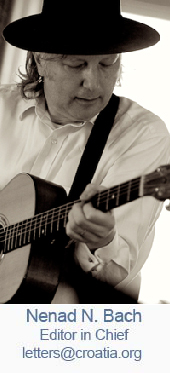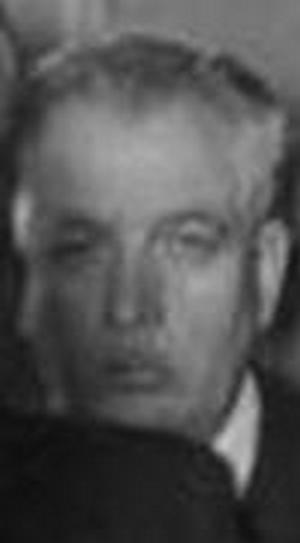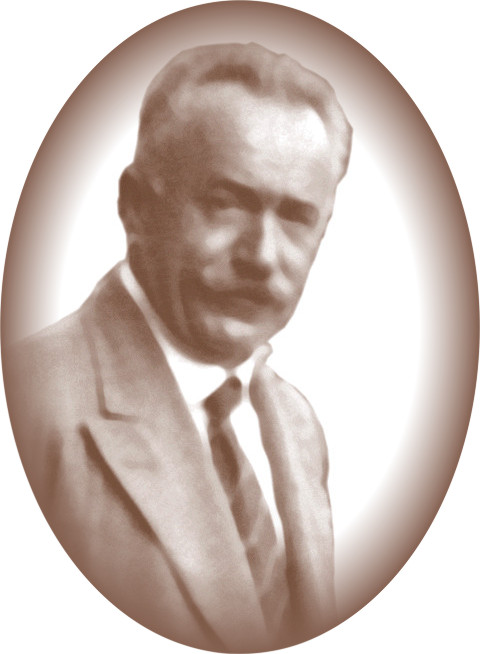
Sponsored Ads
|
» Home
» Science » Dr. Edward L. Miloslavich Croatian investigator of the Katyn Forest tragedy
» Home
» History » Dr. Edward L. Miloslavich Croatian investigator of the Katyn Forest tragedy
» Home
» Education » Dr. Edward L. Miloslavich Croatian investigator of the Katyn Forest tragedy
» Home
» Human Rights » Dr. Edward L. Miloslavich Croatian investigator of the Katyn Forest tragedy
| Dr. Edward L. Miloslavich Croatian investigator of the Katyn Forest tragedy |
| By Prof.Dr. Darko Zubrinic |
Published
04/11/2010
|
Science , History , Education , Human Rights
|
Unrated
|
|
|
|
Our deep condolances to Polish people
This article has been prepared on the occasion of the airplane tragedy of the Polish Government in April 10 2010 near the Katyn Forest in Western Russia.
 Dr. Edward Lucas Miloslavich, Croatian expert in pathology, professor at the University of Zagreb. This is his only photo we know of. Source Polish Wikipedia: pl.wikipedia.org/wiki/Eduard_MiloslavićAppeal. Is there any other preserved photo of professor Miloslavić? Maybe at Marquette University in Wisconsin, USA?
Eduard Miloslavic (1884-1952) was a descendant of Dubrovnik emigrants to the USA, born in Oakland, California. His family returned to Dubrovnik in 1889. Ed studied medicine in Vienna, where he became a professor of pathology. In 1920 an invitation came from the Marquette University in Wisconsin, USA, to take the chair of the full professor of pathology, bacteriology and forensic medicine. In subsequent years "Doc Milo", as colleagues called him, inaugurated criminal pathology in the USA. As an outstanding specialist he was also involved in investigations of crimes perpetrated by al Capone gang. He was one of the founders of the International Academy for Forensic Medicine, member of many American and European scientific societies and academies, and also vice president of the Croatian Fraternal Union (CFU) in the USA. In 1932 he moved to Zagreb, where he was a full professor at the Faculty of medicine until 1944, when he moved again to the USA. He was lecturing also pastoral medicine at the Faculty of Theology in Zagreb, and was known as ardent adversary of abortion and euthanasia. In 1940 he was elected member of the prestigious"Medico-Legal Society" in London, in 1941 promoted the full member of the Tzarist Leopoldine Carolingue Academy of Natural Sciences in Germany, and doctor "honoris causa" at the University of Vienna, where he started his scientific career. For his 1943 investigation of the slaughter of 12,000 Polish officers perpetrated by Soviets in the Katyn wood in 1940, see here. By the end of 1944 he moved again to the USA (St.Louis, Missouri), where he was working until his death. It is important to note that after his initiative in 1941 the Faculty of Medicine in Sarajevo was founded in 1944 during the NDH regime. According to an article published in Vjesnik, December 27, 1992, due to his testimonies related to Katyn wood tragedy, Prof. Miloslavic was sentenced to death in absence by the ex-Yugoslavia. Source www.croatianhistory.net
The English Wikipedia uses the same source without citing it (noticed in April 11 2010, D.Ž.). See here.
|
In 1943 prof.dr. Ljudevit Jurak from the University of Zagreb, colleague of professor Miloslavić, was invited by the International Red Cross Committee to investigate the mass grave in Vinnitsa near the Ukrainian river Bug. Prof.dr. Miloslavic emigrated in time from ex-Yugoslavia to the USA by the end of WWII, while prof. Jurak remained in Zagreb, and was imprisoned on the demand of the Russian NKVD by the Yugoslav communists in May 1945. It was offered to him that he would not be accused as a military criminal and that his life would be spared if he declared that his report for the Red Cross Committee had been signed under pressure. He refused to do so, fully aware of the consequence. The place of his burial place is unknown.
For example, NKVD officers forced Bulgarian specialist Markov to withdraw his signature under the threat of death sentence.
Source: Ljubica Stefan: Ljudevit Jurak - nasa rana i ponos.
Source www.croatianhistory.net

Professor Ljudevit Jurak 1881-1945.
Professor Jurak was dean of the Veterinary Faculty of Zagreb University in 1929/30 and in 1937/38 and vicedean in 1938/39. Prof. Jurak's tragedy began in 1943 when he became a member of the Red Cross International Committee for the investigation of killings of the Polish officers in the Katynian forest and Ukrainian citizens in Vinnica. The forensic investigation of the victims' remains at both locations determined, that the Soviet Secret Services (NKVD) was responsible for the killings of these innocent victims. Due to the fallout his truthful testimony would create with respect to Yugoslav relationship to the Soviet Union, he was executed by the communist authorities in Zagreb on June 10, 1945. In 1990 an annual international memorial symposium on comparative pathology has been established dedicated to Professor Jurak:
EUROPEAN SOCIETY OF PATHOLOGY and ACADEMY OF MEDICAL SCIENCES OF CROATIA LJUDEVIT JURAK INTERNATIONAL SYMPOSIUM ON COMPARATIVE PATHOLOGY
More information about professor Ljudevit Jurak can be seen at the Clinical Hospital "Sisters of Mercy"
21st "Ljudevit Jurak" International symposium in comparative pathology, Zagreb, June 4-5 2010
Clinical Hospital "Sisters of Mercy", Zagreb, Croatia
Another reference: Fatović-Ferenčić, Stella; Dugački, Vladimir, Ljudevit Jurak (1881-1952)and Eduard Miloslavić (1884-1952) Founders of Croatian pathological and forensic medicine and experts at the investigations of mass graves at Katyn and Vinnitsa During World War II, pp 189-201, chapter in the book Katyn and Switzerland. Forensic Investigators and Investigations in Humanitarian Crises 1920-2007, Debons, Delphine; Fleury, Antoine; Pitteloud, Jean-Frnancois (eds.), Geneve 2009
Abstract. The chapter concentrates on biography of two eminent Croatian physicians, Ljudevit Jurak (1881-1945) and Eduard Miloslavić (1884-1952), their role in the process of professionalization of pathological and forensic medicine in Croatia and their involvement in the investigation of communist war crimes in Katyn and Vinnitsa during the World War II. The field of pathologic anatomy in Croatia actually opened with Ljudevit Jurak’ s appointment as a prosector in Public Health Institutions of the city of Zagreb in 1913. Twenty-two years later, in 1935, Eduard Miloslavić founded the Department of Forensic Medicine of the Zagreb University. In 1943, Miloslavić was invited as a medicolegal expert in an International Committee to investigate the massacre in the Katyn forest near Smolensk, and Jurak to investigate the mass grave in Vinnitsa near the Ukrainian river Bug. Both medicolegal investigations proved that crimes were committed by Soviets. However, Jurak and Miloslavić’ s part in those investigations had a dramatic impact on their future. Jurak was arrested by the Yugoslav political police in 1945, deprived of human rights, and condemned to death. To this date, his burial place is unknown and until 1990, his name had rarely been mentioned. Miloslavić managed to escape from Yugoslavia and never came back.
Source Croatian Scientific Bibliography
|  Madonna with her Child, a small amulet found with one of the Polish victims in the Katyn Forest. Source Katyn FilesThe last page of the protocol. The signature of Dr. E.L. Miloslavich is the last one in the second row.  Dr. Miloslavich's signature under the final protocol of the International committee in 1943. Source Polish Wikipedia: pl.wikipedia.org/wiki/Eduard_Miloslavić
Dr E L Miloslavich
US Congress Hearings in 1951 and 1952 on Katyn War Crime
Dr. Miloslavich gave the following testimony to the committee relative to the condition of the bodies as they were found in the mass graves:
"One body was placed on top of the other one, with their faces down. They were close together, nothing between them. All the bodies were dressed in Polish officers' uniforms, the clothing being winter clothing, underwear, and the uniforms; and coats on some. The heads were downward. One body like this, the next one like this, and the next one like this [indicating]. This was the width of the grave. Then 12 layers down, and then multiply by the length. I don't remember how many we found in the length. Anyway, at that time when I was examining and making my own estimations I didn't follow anybody, and no one tried to give me any advice because I knew what to do. I estimated approximately 2,870, something like that, a little less than 3,000 officers.
They were packed completely together by decaying fluids of the human body, the decomposing fluids, with started to penetrate, to imbibe, to infiltrate every dead body in there. That was a solid mass in which you just saw skulls you could recognize and that they were human beings.
Then I went into the graves and studied which ones of them would give me the best information, what the dead body could tell us. With the help of two Russian peasants I picked a body, and slowly and gradually-it took them close to an hour-they removed the body and brought it out. I examined it very carefully to find out two main points. First, what was the cause of death? Second, how long a time was this individual buried? Third, who he was?
In examining the body I found a gunshot wound at the boundary between the back of the neck and the head. The Germans gave the expression `nacken schuss.' That is the precise description of the shot which was fired. The majority of them had just one shot, because it entered in here [pointing with finger] and came out here at the root of the nose, which means the head was bent downward. It was administered with such precision that the medulla was completely destroyed." (See pt. III of the published hearings.) Source kanada.net/war/us_congress_doc4.html
|
Dr. Eduard Miloslavić Rođen je 20. prosinca 1884. u Oaklandu u Kaliforniji (SAD), od oca Luka iz Postranja, iz Lapačina - Župa dubrovačka i majke Vice rođ. Milković; umro je u St. Louisu, država Missouri, SAD 11. studenog 1952. g. Znanstvenik je svjetskog glasa, ugledni sveučilišni profesor, poznat je u povijesti hrvatske i svjetske medicine. Otac Luko iz Postranja 1878. g. odlazi u Dubrovnik, te se iste godine ženi Vicom. Nedugo zatim, kao hrvatski emigranti, napuštaju Dubrovnik iz ekonomskih razloga i sele se u Sjedinjene Američke Države. Živjeli su u Kaliforniji, u gradu Oaklandu i tu im se rodilo više djece među kojima i Eduard. Nakon pet godina, ne mogavši se naviknuti na život izvan domovine, vratili su se u Dubrovnik. Tu je Eduard završio osnovnu i srednju školu, a potom je izabrao studij medicine na sveučilištu u Beču. Već kao student bavio se znanstvenim radom, a svoje članke je objavljivao u dubrovačkim periodičkim listovima. Završivši studij, kao doktor medicine, bio je asistent za patološku anatomiju na Medicinskom fakultetu u Beču. Istodobno je surađivao i s Patološkim institutom Vojne bolnice u Beču, pa se tu istakao kao znanstvenik. U prvom svijetskom ratu bio je mobiliziran u austrougarsku vojsku, a kao vojni liječnik je radio i u Beogradu. Godine 1917. nominiran je docentom na bečkom sveučilištu, a potom i profesorom patologije. Pri kraju rata njegov je ostanak u Beču postao nesiguran i tako je 1920. prihvatio poziv Marquette University u Milwaukee, sav. država Wisconsin, SAD, i odselio u SAD, pa je kao profesor patologije na tom sveučilištu preuzeo Katedru patologije, bakteriologije i forenzičke medicine. Od 1923. osim što je predavao na Sveučilištu, bio je i glavni liječnik sudski vještak u državi Wisconsin. Slijedećih godina, Doc Milo, kako su ga kolege zvale, bavio se znanstvenim istraživanjem na polju forenzičke patologije, pa je u SAD-e inaugurirao novu specialnost – kriminalističku patologiju. Kao istaknuti specialist bio je uključen u istraživanja kriminalnih nedjela Al Caponeove družine. Bio je vrlo popularan u svojoj sredini i u znanstvenim krugovima. Jedan je od osnivača International Academy for Forensic Medicine. Postao je članom mnogih američkih i europskih znanstvenih udruženja i akademija. Usto je bio vrlo aktivan među hrvatskim emigrantima, surađujući u njihovim udrugama; bio je i podpredsjednik Croatian Fraternal Union (CFU) u SAD-u. Kada je učenje sudske medicine postalo obveznim na Medicinskom fakultetu u Zagrebu, imenovan je redovnim profesorom i šefom Katedre za sudsku medicinu 1932. godine i pozvan je u Zagreb , gdje se potom i doselio iz SAD-a. Tu je osnovao i Institut za sudsko vještačenje; tijekom tri godine napravio ga je gotovo savršenim, pa je smatran najboljim u Europi i Americi. U Institutu je imao labaratorij s balistoskopom, histološki i kemijsko-toksikološki labaratorij, bogati arhiv s fotodokumentacijom, knjižnicu i muzej. Bio je također predavačem pastoralne medicine na Bogoslovnom fakultetu u Zagrebu. Podučavao je buduće svećenike o problemima zaraze s bolesnicima i umirućima, i mogućim psihopatološkim problemima u ispovijedaonicama. Energično se borio protiv abortusa i eutanazije, iskorištavajući svaku priliku kako bi iznio svoje gledište. Godine 1937. na tom je fakultetu proglašen i počasnim profesorom pastoralne medicine. Kao znanstvenik, postao je poznat u cijelom svijetu, pa su mu nudila mjesta istaknuta udruženja liječnika iz Njemačke, Austrije i Londona. 1940. bio je izabran članom prestižnog "Medico-Legal Society" u Londonu, 1941 unaprijeđen je stalnim članom Tzarist Leopoldine Carolingue Academy of Natural Sciences u Njemačkoj i doktor honoris causa (počasni doktor) na sveučilištu u Beču, gdje je i započeo svoju znanstvenu karijeru. Godine 1941. postao je dekanom Medicinskog fakulteta u Zagrebu; pri nominaciji održao je slavan govor, u kojemu je istaknuo obvezu liječnika da bude primjer, i u medicini i u moralu. Nakon njegove inicijative 1941., već 1944. bio je u Saraevu osnovan Medicinski fakultet u vrijeme NDH režima. Zbog svijetske slave liječnika sudskog viještaka i specijalista za sudsku medicinu, a posebno za balistoskopiju, kao jedan od predstavnika International Committee of Red Cross 1943. član je Međunarodnog povjerenstva, koje istražuje masovni zločin u Katynskoj šumi u Poljskoj. Naime, tijekom zime 1942./43. godine u toj je šumi, 17 km od Smolenskog, pokraj rijeke Dnjepra, u blizini poljskog grada Katyna nađeno sedam velikih jama u kojima je bilo zatrpano 12.000 ubijenih poljskih časnika likvidiranih na početku Drugog Svijetskog Rata. Povjerenstvo je imalo 12 članova, istaknutih svjetskih viještaka iz sudske medicine. Oni su utvrdili pravu istinu o tom masovnom zločinu u Poljskoj; počinio ga je sovijetski komunistički režim, koji je cijelokupni časnički kadar poljske armije likvidirao u Katynskoj šumi u mjesecu ožujku ili travnju 1940. godine. Poradi te istine, koju je s Međunarodnom komisijom utvrdio, prof. Eduard Miloslavić morao je koncem 1944. godine, pod pritiskom komunističkog režima u Zagrebu, kao persona non grata, napustiti Zagreb i Hrvatsku, pa se vratio u SAD, u St. Louis, Missouri. Tu je bio predavačem na tamošnjem sveučilištu kao profesor sudske medicine, proslavljeni "majstor od balistoskopa", sve do svoje smrti 1952. godine. Source hr.wikipedia.org/wiki/Eduard_Miloslavić
| Formated for CROWN by prof.dr. Darko Žubrinić
Distributed by www.Croatia.org . This message is intended for Croatian Associations/Institutions and their Friends in Croatia and in the World. The opinions/articles expressed on this list do not reflect personal opinions of the moderator. If the reader of this message is not the intended recipient, please delete or destroy all copies of this communication and please, let us know! |
Related Articles
Related Links
|
|